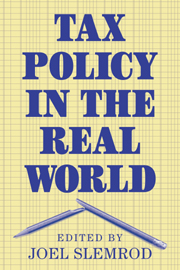Book contents
- Frontmatter
- Contents
- List of contributors
- 1 The real world of tax policy
- 2 Federal tax reform
- 3 Federalism and subfederal taxes
- 4 Principles, politics, and the professors
- Public finance in theory and practice
- On the use of ‘distribution tables’ in the tax policy process
- Taxation and economic growth
- Tax reform of the century – the Swedish experiment
- Measuring the impact of tax reform
- What is an ‘optimal’ tax system?
- How tax complexity and enforcement affect the equity and efficiency of the income tax
- Tax policy from a public choice perspective
- What is missed if we leave out collective choice in the analysis of taxation
- Public finance and public choice
- Professional opinions about tax policy: 1994 and 1934
- What can America learn from the British tax system?
- Peculiar institutions: a British perspective on tax policy in the United States
- Index
On the use of ‘distribution tables’ in the tax policy process
Published online by Cambridge University Press: 01 June 2010
- Frontmatter
- Contents
- List of contributors
- 1 The real world of tax policy
- 2 Federal tax reform
- 3 Federalism and subfederal taxes
- 4 Principles, politics, and the professors
- Public finance in theory and practice
- On the use of ‘distribution tables’ in the tax policy process
- Taxation and economic growth
- Tax reform of the century – the Swedish experiment
- Measuring the impact of tax reform
- What is an ‘optimal’ tax system?
- How tax complexity and enforcement affect the equity and efficiency of the income tax
- Tax policy from a public choice perspective
- What is missed if we leave out collective choice in the analysis of taxation
- Public finance and public choice
- Professional opinions about tax policy: 1994 and 1934
- What can America learn from the British tax system?
- Peculiar institutions: a British perspective on tax policy in the United States
- Index
Summary
INTRODUCTION
The distribution of tax burdens (and government expenditures) is a fundamental question in both public economics and public policy. Positive and normative analyses in public economics have focused on the incidence and effects of tax and expenditure policies on the distribution of economic well-being. Tax policy debates among policymakers are grounded in no small part in policymakers' perceptions of the effects of policy changes on the distribution of economic well-being. The study of incidence is an active area of research among economists, though the contributions of recent research are not always integrated in the distributional assessments presented to policymakers.
Since 1990, the preparation of “distribution tables” has been an area of increasing activity for staff economists in the administration and Congress and for economists in private organizations advising taxpayers (and for academic economists serving in the government, as I can painfully attest). While there are many reasons for this recent growth, two seem particularly prominent: (1) the heightened concern over income inequality in the 1980s (with the attendant concerns that the federal tax system may have been partially responsible and, in any event, should be used to redress changes); and (2) the increasing ability of staff economists to prepare detailed tables quickly using modern computer technology and microsimulation models. Whatever the reason, the higher profile of distribution tables has aroused worries by economists in and out of government that the tables do not necessarily convey the appropriate information (or, in some cases, lack of information) to decisionmakers.
- Type
- Chapter
- Information
- Tax Policy in the Real World , pp. 293 - 304Publisher: Cambridge University PressPrint publication year: 1999
- 1
- Cited by

